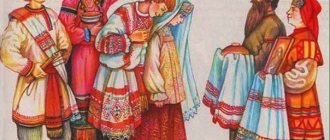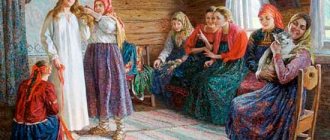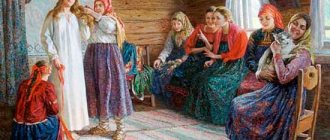Russia is a unique and multinational country, whose inhabitants carefully preserve their centuries-old traditions and customs. Many of them are not only Christian, but also pagan. Russians never stop believing in folk legends and omens. Any solemn event is accompanied by ritual actions. Traditions and customs of Russia are manifested in such holidays as New Year, Christmas, Epiphany, Easter, Maslenitsa.
The New Year is not complete without making wishes during the chiming clock; on Epiphany and Christmas it is customary to go to church, and in the evening to gather at the festive table with the family. On Christmastide and Ivan Kupala, fortune telling is performed and various rituals are performed. It is worth taking a closer look at each holiday and the traditions associated with it.
Various traditions of Russia
More than 150 peoples live in Russia, half of which are considered indigenous. Folk culture and traditions are the foundation of every nationality. There are some customs and rituals that have become established only among the Russian people and arouse great interest and delight among foreigners. It is worth considering briefly the traditions of Russia :
- Toasts. In Russia, if they drink, it’s always for something. At any feast, it is customary to raise glasses and toast to health, love, peace, children, and parents.
- Gatherings in the kitchen. Every nation has a kitchen, but only Russians have a tradition of gathering around the table in the evenings and having intimate conversations. While such a custom is not common in Europe, for Russians it is a whole culture.
- Russian bath. Every Russian soul has a special love for the bathhouse. In ancient times, rituals of purification of the bride and groom, a newborn and a woman in labor were performed in the baths, and they exorcised evil spirits from the mentally ill. Today, in the bathhouse you can relieve fatigue, stress, improve your health, and relax your soul and body. According to Russian tradition, after the steam room you must jump into cold water or a snowdrift.
- Bread and salt. One of the oldest customs that is not forgotten in our time. It was customary to greet distant guests with bread and salt, as well as treat the bride and groom. By breaking off a piece of bread and dipping it in salt, the guest confirms his trust and good attitude towards the hosts.
- Bride ransom. One of the most popular and widespread Slavic wedding rituals. Its meaning is that the groom must make a real or symbolic payment for his beloved.
Caroling
Carols are celebrated on January 7 in the morning or evening of January 6, after the appearance of the first stars.
carols
According to tradition, the ritual of home owners promised a good harvest in the garden, in the fields, a large inventory and general well-being.
Therefore, chanters always tried to visit as many houses as possible, except those in which someone had recently died. According to tradition, they usually start from west to east, in the village and in the mountains from the bottom up.
The ritual takes place in three stages:
- Preliminary preparation - singing, testing, searching and trying on costumes.
- The main round of kolędniczy is a gathering of participants in one place, a hike through the village, contact hosts, delicious gifts to receive.
- The last and final dish is chanted together at the end of the ceremony.
In Russia it was believed that singing carols drives away evil spirits and diseases. The rituals were described by messengers of God or guests as unprecedented.
Family traditions in Russia
Family traditions are usually understood as a certain set of norms and rules that apply in a particular family. This includes customs, behavior, and views passed down from generation to generation. Family traditions in Russia contribute to the harmonious development of children, give a feeling of unity to all family members, bring them closer and strengthen feelings. It is worth highlighting some of the main customs and traditions of Russian residents :
- Every person should know his ancestry. Knowledge is not limited to great-grandparents, but goes much deeper. Many families have a family tree, which is carefully kept and allows you to better learn the history of the family and ancestors.
- Since ancient times, it has been customary to pass on family heirlooms to your children and grandchildren. This could be expensive jewelry, dishes and any other valuable items. In the past, it was quite common to hear stories of women saving their wedding dresses for their daughters, and grandmothers passing jewelry on to their granddaughters on their wedding day.
- Previously, it was customary to name sons and daughters after mothers, fathers, grandmothers or grandfathers.
- Assigning a patronymic to a newborn is one of the main Russian traditions. From the first days of birth, the child becomes part of the family name.
- Previously, newlyweds had to get married in church and have their child baptized.
Many Russian families still adhere to all these traditions. In the modern world, new customs continue to appear, which have already become quite entrenched among the inhabitants of the country. These include the procession of the Immortal Regiment, which takes place every year.
Each family may have its own specific traditions, for example, going on vacation to the sea every year, baking cakes every weekend, giving everyone gifts for the holidays, or getting together for Christmas with the whole family.
USA
In the United States of America, it is customary to celebrate almost any event. This list includes birthdays, weddings, the birth of children or pregnancy, and much more. For the hero of the occasion, for example, guests usually arrange a procedure called showering.
What gifts are they showering? It all depends on the occasion. These can be items useful in the household (towels, pancake pans or vases), but you can also receive very frivolous gifts.
New Year
New Year is considered one of the favorite holidays of Russians. Every resident knows the saying: “How you celebrate the New Year is how you will spend it.” No holiday takes place so brightly and on such a large scale.
The tradition of celebrating the New Year dates back to ancient times. Initially, it was associated with the revival of nature, so it was celebrated on March 22. With the advent of Christianity in the country, a new chronology system was introduced and March 1 became the official date of the New Year. In the mid-14th century, changes were made according to the Nicene canons and September 1 became the holiday date. And only at the end of the 17th century, by order of Emperor Peter the Great, the New Year began to be celebrated on January 1.
In each country this holiday is celebrated differently. It is worth taking a closer look at what traditions there are in Russia for the New Year and what is customary to do on this day :
- Gather with family and friends. Most people are used to celebrating the New Year in a warm home atmosphere, surrounded by loved ones. On the evening of December 31, they set the table, serve the best dishes, raise glasses of foaming champagne to the chimes and make wishes.
- Decorate the house. Since ancient times, people have loved to create a festive atmosphere. Previously, vegetables, fruits, and sweets were used as decorations. Only after a while did the usual paraphernalia begin to appear in the form of garlands, glass balls, rain, and streamers. Today, stores offer a huge range of New Year's decorations.
- Give gifts. No holiday can be imagined without gifts. From December 31 until Christmas, people visit guests, congratulate them on the New Year, and give gifts. Most often they choose thematic gifts.
- Watching New Year's films. Many films have been made on the theme of the magical winter holiday, which we never tire of watching every year.
Not a single New Year can be imagined without the main characters - Father Frost and Snow Maiden. Young children look forward to them with great anticipation.
Tradition of decorating the Christmas tree
In many countries, it is customary to decorate the Christmas tree for the New Year. Any coniferous tree is considered a symbol of the holiday. Often people buy pine instead of a Christmas tree.
The emergence of this tradition has a long history. Our ancestors also believed in the strength and power of the World Tree, which was considered a symbol of life. Every nation revered evergreen trees. Initially, it was not customary to cut fir and spruce trees and take them home, so they were decorated right on the streets, in the forest. Later they began to cut them down and install them at home. This tradition quickly took hold among Russians. Nowadays, artificial Christmas trees have been invented, which have become very popular.
Usually the tree is put up a few days before December 31 and removed only after the Old New Year. Balls, glowing lanterns, cones, rain, sweets, and New Year's figures are used as decorations. Many people try to adhere to a single design style, taking into account the color palette that the owner of the coming year prefers.
Türkiye
A Turkish man cannot get a second wife until he gives the first one gold jewelry worth at least ten thousand dollars. It is generally accepted that this is how a man can confirm his financial solvency and prove his ability to support several wives.
It is not very civilized to talk at the table without asking permission from the owner of the house, and you should not choose pieces of food from the common dish too carefully. And if you decide to use a toothpick, then you should do it with your hand over your mouth, as if you were playing a harmonica.
Christmas
The second significant Orthodox holiday is the Nativity of Christ, which is celebrated on January 7. According to the Gregorian calendar, this date is associated with the birth of Jesus Christ. The customs and traditions of the peoples of Russia did not bypass this holiday. In addition to the usual Christmas trees, it absorbed Slavic features and was replenished with rituals and ceremonies :
- Burning of the sheaf. It is generally accepted that the agricultural year ends at Christmas. In the fall, during the harvest, the best sheaf is collected, which is stored in the red corner of the house. In order for the next year to bring even more harvest, it is burned on Christmas night.
- Signing contracts. Merchants considered the period from the Nativity of Christ to Maslenitsa the most favorable for concluding serious transactions.
- Nativity scene and Kolyada. Christmas customs in Russia have incorporated European traditions. At Christmas, theatrical performances are held on the theme of the birth of the baby Christ. Such performances are called nativity scenes. Residents of the villages dressed up and gathered in the main squares where the puppet theater took place. Kolyada is the custom of visiting guests and singing songs glorifying the holiday.
- Christmas Eve. This is the name of the day before Christmas. It is customary to prepare a traditional dish consisting of porridge, poppy seeds, nuts and honey. Any other food cannot be eaten until the first star. After the evening feast, the owner collects the leftover food and shares it with the animals.
The appearance of the first star in the sky meant the end of the Nativity Fast. The best and most satisfying dishes of meat and fish were prepared for the holiday. The menu included pancakes, rolls, and kulebyaki.
Rituals
All rituals in Rus' were dedicated to important events in a person’s life. The naming ritual was considered one of the most important, since the Russians believed that a person’s entire life depended on the name.
Naming
The Slavs believed that the name determines the future fate of a person, and also protects him from evil spirits. The naming ceremony could be performed several times for one person. The first name was given to the child by the father at birth. At a young age, the name was changed - the priests washed the teenagers in sacred waters, ridding them of childhood sins. Also, the name was changed during marriage, during illness or as a result of heroic deeds.
For boys, this ceremony took place only in the river, and for girls - in a river or lake. The person being named had to hold a burning candle in his hand. After the priest’s words, one had to plunge one’s head into the water and hold the candle at arm’s length.
Fraternization
Among pagan customs, the ritual of fraternization, during which warriors exchanged crosses, was popular. In this way, the warrior made it clear to his comrade that he honors him as a warrior and considers him his brother. When exchanging crosses, a person swore an oath to a friend that he could always be relied upon.
Wedding
Among the ancient Slavs, a wedding was accompanied by many rituals from the moment of preparation. During the engagement, the newlyweds had to wash each other with decoctions of medicinal herbs in order to cleanse themselves of sins before marriage. For the wedding ceremony, the bride was dressed in a white shirt with special symbols.
Karavai was present at every wedding. It had to be round in shape so that the young people would live well and satisfyingly. Relatives were invited using a special ritual called requestin, and the mother escorted her son to the new home with the help of prayers. The groom's family had to give a ransom for the bride, and the girl's parents prepared a decent dowry. There were several ransoms at the wedding, and they ended with a toast. During the celebration, the bride's braid was unraveled or cut off and her head was covered with a cap - a symbol of marriage.
After the exchange of rings, the following folk rituals began:
- posag – transfer of dowry;
- komora - checking the bride for purity and preparing for the first wedding night;
- matchmakers - newlyweds treated relatives and accepted gifts from guests.
tonsure
The ancient rite of tonsure was carried out in honor of the separation of a child from his mother. From early childhood, the mother helped the baby learn about the world and formed his understanding of the world around him. Men began to take care of their sons only after tonsure. Until this time, the child was considered a fragile creature, not adapted to life. Men had to instill in the boy the role of a man, teach him hunting, fishing, crafts and military affairs.
The ancestors' ritual took place on a sunny day. The list of items for the ritual is as follows: bandage, hryvnia, missal, stool, scissors, white shirt, honey. A guy in a white shirt sits on a stool, and a fire is lit next to him. An elder in a headband cuts off the guy's hair and burns it to appease the gods. At this point the ritual ends, and the young man is considered an adult man. After this, everyone present is treated to honey, and the musicians play the harp.
Trizna
According to the tradition of the Old Believers, after the funeral they held a funeral feast - a kind of wake. During this old Russian ritual, stylized fights with a three-headed snake were staged. Such commemorations helped the deceased find peace in the afterlife. During paganism, sacrifices were made at funeral feasts, songs were sung and danced in honor of the deceased. After the adoption of Christianity, this custom was replaced by funeral services.
Christmastide
Slavic Christmastide lasts two weeks - from January 6 to January 19. At this time, magical rituals and fortune telling are performed. This week is considered the beginning of the new year according to the Orthodox calendar. It includes the celebration of Christmas, Old New Year, Epiphany.
National traditions of Russia on Christmastide:
- Unmarried girls tell fortunes about their grooms.
- Young people sow, sing carols, and perform rituals for well-being.
- Every home receives guests, sets tables and prepares the best treats.
It is believed that at this time the presence of spirits is especially felt among the living, which allows you to look a little into the future. On Christmas Day, there is a surge of joy and energy, a cheerful and joyful atmosphere reigns, people walk, have feasts, accompanied by songs, dances and sincere conversations. On these days it is prohibited to hunt any living creatures.
Rituals when receiving guests
Russians are very hospitable - hospitality has always been the main distinguishing feature of the Slavs. She showed the greatness of the human soul and material generosity. The hospitable host was ready to treat the guest with the best delicacy and share everything with him.
Important: receive, feed, put up, give something for the journey - such a manifestation of hospitality was natural for a Russian.
In every house a guest was welcomed, greeted with bread and salt, a hot meal, pleasant conversation and a caring environment.
Epiphany
Epiphany Christmas Eve is celebrated on January 19. The holiday is associated with the baptism of Jesus Christ. On this day, all water is considered holy. Epiphany bathing is organized in consecrated fonts, and ice holes are created. They bring water to church to bless, which is usually drunk in the morning on an empty stomach. It is also kept in the Red Corner of the home throughout the year, and is used for healing purposes and for consecrations.
The bravest ones go swimming in the ice hole. You need to plunge your head 3 times, saying the prayer: “In the name of the Father, and the Son, and the Holy Spirit.”
On Epiphany of the Lord any work is prohibited. This day is dedicated to physical and spiritual cleansing. A person’s thoughts should be bright and pure, aimed at a bright future, gratitude to God for life, mutual assistance to loved ones.
Ivana Kupala
St. John the Baptist, or the Feast of John the Baptist, has long been considered one of the most grandiose and fun holidays.
On the night before the holiday, young people wove wreaths for themselves, then threw them into the water, lit bonfires, jumped on them and danced in circles.
Girls dip garlands in water.
It was believed that on St. John, nature reveals all its life-giving powers. At midnight the fern blooms, and those who find it become all-seeing and begin to understand the language of plants and animals.
Salvation in the name of the Savior Jesus Christ. Since ancient times, Orthodox Christians have celebrated three holidays a year:
- August 14 - Honey Spas.
- August 19 - Apple Savior.
- August 29 - Savior of bread or Savior of nuts.
Each of them has its own symbol: honey, apples, bread. About this day it was said:
“The first Savior stands on the water, the second Savior eats apples, the third Savior sells linen in the green mountains.”
People translate the name of the holiday in their own way - in the best harvest traditions: “to save”, to preserve the harvest for the long winter.
Maslenitsa
Before Lent, Maslenitsa week begins. This is the time to say goodbye to winter and welcome spring. The holiday begins on Sunday (it is called the meat fast). This is the last day before Easter when you can afford meat. Pancakes are baked throughout the week. The traditional Russian dish is a symbol of the sun. It is customary to visit guests all week, and the main treat, of course, is pancakes with different fillings. They serve teas and make honey sbitni. A huge samovar with hot drinks is placed in the center of the table.
A holiday is not complete without winter activities. Adults and children ride sleds and play snowballs. The main symbol of the holiday is the image of winter in the form of a straw effigy. It is installed in the main squares and set on fire.
The cultural traditions of Russia are associated with folk festivals. During the week it is customary to have fun, sing, dance, stage theatrical performances, joke, and have funny fights. Parsley is the favorite doll of the Russian people. Young people dress up in their best suits, walk the streets, and single girls and boys are actively looking for a mate.
Bratchina
If you delve into history and look for which rituals and customs of the Russian people were the most fun and populous, then the brotherhood will take one of the main places. This was not a spontaneous gathering of people and a mass celebration. They had been preparing for this ritual for months. Especially for the brotherhood, livestock was fattened and beer was brewed in large quantities. In addition, drinks included wine, mead and kvass. Each invitee had to bring a treat. The place for the holiday was chosen by all honest people. A random person could not get into the brotherhood - everyone had to receive an invitation. At the table, the most honorable places were occupied by people whose merits were valued most highly. Buffoons and singer-songwriters came to entertain the feasters. The festivities could last several hours, and sometimes several weeks.
Easter
This Christian holiday does not have a clear date. Every year it is celebrated on a different day - on the first Sunday after the full moon after March 21st. The holiday is associated with the resurrection of Jesus. This is the first day after a long fast. Housewives begin to actively prepare for the holiday a few days in advance - they boil and paint eggs, bake Easter cakes and cottage cheese muffins. All prepared food must first be blessed in the church. In addition to the main Easter dishes (Easter cakes and eggs), the basket contains dairy and meat products.
After visiting church you need to eat holy food. From the very morning and throughout the day, people visit guests, have feasts, and have fun. The greeting begins with the phrase “Christ is Risen ,” to which one should respond “Truly He is Risen . After this, they kiss on the cheek 3 times. The main folk pastime is breaking eggs.
Carols
The culture, customs and rituals of the Russian people are closely connected with the world of nature and animals. In the evenings, young people went to caroling. Dressed up in animal skins or bright costumes, they knocked on houses and begged for food from the owners with carol songs. Refusing such guests was fraught with risk - they could easily destroy the woodpile, freeze the door, or commit other minor mischief. Carolers were treated to sweets and it was always believed that their wishes (generosity) would ensure prosperity and peace in the house for the whole year, and save the owners from illnesses and misfortunes. The custom of dressing up as animals is rooted in paganism as a way to scare away evil spirits.
Tea drinking traditions in Russia
Not only the British, Turks, Chinese and Japanese have tea drinking traditions. Among the Russian people, tea drinking is accompanied by a richly laid table with various snacks, in particular sweet ones. Tea drinking traditions in Russia began to emerge at the end of the 17th century. At that time, tea was considered a very expensive product and it was difficult to get it. It was supplied from China. Until the end of the 19th century, only representatives of noble and elite society could afford it. The tradition of tea drinking quickly spread among the people thanks to the Russian custom of brewing herbs. People also considered it a great way to keep warm in cold weather.
It was Moscow that became the capital of tea houses, where negotiations were held and deals were concluded. Russians never have a tea party with just one mug of hot drink. It is always served with light snacks and sweets. The most common are salty and sweet pies, bagels, honey, jam, gingerbread, various baked goods, and candies. After such a feast it is impossible to get up feeling hungry.
For a long time, a purely Russian invention, the samovar, was a mandatory attribute. Tea was brewed in a separate teapot and diluted with boiling water from a samovar. In the villages during the warm season, it was customary to organize evening feasts, at which whole families would gather, invite friends and neighbors, slowly drink tea and have conversations. Tea drinking traditions have survived to this day. An invitation to tea is a common occasion for meeting relatives and friends. Guests, in turn, always bring something tasty to the table. It could be sweets, cakes, cookies.
Culinary traditions of Russia
Until the 14th century, Russian cuisine was nothing special. The food was simple and fairly monotonous. Hot dishes were cooked and stewed in ovens. Frying was unknown in those days. Since there were many fasting days throughout the year, dairy and meat products were rare. Fish, vegetable and mushroom dishes were more often present on the table.
The development of foreign trade made a significant contribution to the development of Russian cuisine. Differences appeared in the menus of the rich and the poor. If earlier the feast differed in the amount of food, then during this period the range of products changed. Ordinary people could afford meat dishes only on holidays, and these were real culinary masterpieces that have survived to this day - duck with apples, baked pig, chicken with sweet sauce. On ordinary days, their menu was meager - fish, vegetables, cereals, baked goods, berries.
The preferences of the kings made a significant contribution. Servants often shared the secrets of their favorite recipes, which quickly spread throughout the area. In rich and noble families, it was customary to serve at least 30 different dishes for lunch and dinner.
In the late 20th and early 21st centuries, history changed at a rapid pace. There is a division of Russian cuisine into Soviet and post-Soviet. Due to historical events and departures from some Russian traditions, many recipes for Russian dishes were lost.
The culinary traditions of Russia combine elements of the culture of various peoples living in the country. Traditional dishes include:
- soup, borscht, solyanka;
- porridge;
- jelly;
- tea with jam;
- dumplings;
- cabbage soup;
- pancakes;
- aspic.
The list doesn't end there. In addition to national dishes, each region of the country has its own unique recipes and cooking secrets.
Russian loaf
One of the most famous Russian flour dishes, which was prepared for holidays (for example, for a wedding) exclusively by married women and placed on the table by men, is the loaf, which was considered a symbol of fertility, wealth and family well-being. The loaf is decorated with various dough figures and baked in the oven; it is distinguished by its rich taste and attractive appearance, worthy of being considered a real work of culinary art.
Read more >>
Labor traditions of the peoples of Russia
In the life of any people, including Russians, labor activity has played and continues to play an important role. It is considered one of the main means of moral education of people.
The labor traditions of the peoples of Russia may differ not only in different regions, but also in each family. Modern youth grow up outside the labor process. Any full-fledged personality must have at least elements of labor education. From a very early age, it is customary to instill in a child a love of work, teach him to help adults and those in need, and to benefit others. These tasks fall on the shoulders of not only parents and grandparents, but also educators and teachers.
As a person grows up, he must understand the meaning of work in life, he must appreciate the efforts of any person. In the past, it was a shame to be lazy; such people were treated with contempt and even hatred. Only by doing something useful could a person grow morally. There are many Russian sayings and fairy tales about this. A striking example is the well-known fairy tale about Ivanushka the Fool.
It has long been accepted that sons learn farming and animal husbandry skills from their fathers, and daughters learn sewing, cooking, knitting and housekeeping skills from their mothers. However, for representatives of princely and noble families, any work was considered a shameful occupation. In such families, children were taught horse riding, shooting, drawing and developed various creative skills.
Today, labor traditions continue to be set as the main goal of moral education of children, adolescents and adults.
Through me
The basis of the centuries-old culture of the Slavs has always been family, clan, and continuity of generations. The rituals and customs of the Russian people entered a person’s life from the moment of his birth. If a boy was born, he was traditionally swaddled in his father's shirt. It was believed that in this way he takes on all the necessary masculine qualities. The girl was wrapped in her mother's clothes so that she would grow up to be a good housewife. From an early age, children revered their father and unquestioningly fulfilled all his demands and wishes. The head of the family was akin to God, who gave continuation to his family.
In order for the child to receive a blessing from higher powers, not get sick and develop well, the father presented his heir to the deities. First of all, he showed the baby to Yarila, Semarglu and Svarog. The Gods of Heaven must give their protection to the baby. Then it was the turn of Mother Earth, or, as she was otherwise called, the Goddess Mokosh. The child was placed on the ground and then dipped into water.
Student traditions in Russia
Students are a separate society with their own traditions and customs. The most common student traditions in Russia include :
- Initiation as a student. The custom appeared many years ago. It all started with the fact that the second-year students, after the next session, felt like real “pros” and decided to teach the green freshmen their wits. This custom has taken hold, and now the beginning of a new academic year is not complete without initiation into students. First, the events are held within the educational institution, after which students continue the celebration in entertainment and dance establishments.
- Equator. This is a holiday when half of school is left behind. It is usually noted after the first session of the 3rd year or before moving on to the 4th year.
- Student's day. It falls on Tatiana's day. This holiday is so widespread that it can be considered a state holiday. Although this is not a day off, many students do not mind skipping classes and having fun, and teachers make concessions to them and make concessions.
Separately, it is worth mentioning rituals aimed at attracting good luck during the session and defense of the diploma . Examples include:
- Do not wash your hair before the exam.
- Shout out the window “Freebie come.”
- Place a nickel under the heel of your shoe.
- Do not cut your hair while taking exams.
- Scold a student before an exam.
In addition, each university and specialty may have its own traditions.
Funeral rites
The Slavs believed that by moving to the world of the dead, the deceased opens the door to the afterlife, and evil spirits can come from there. Therefore, Slavic funeral rites were aimed at protecting the living:
- women covered their heads with scarves and wore belts with amulets;
- things that could be useful to the dead in that world were placed in the grave;
- a clean towel was hung on the window;
- There were pancakes and a glass of alcohol left on the grave.
The Slavs follow these and other customs to this day. In order not to forget about Russian rituals, they are revived as part of folklore festivities. People remember legends, find old savvy people keeping the secrets of the past. They decipher the meaning of ancient amulets, celebrate ancient holidays and tell children about the traditions and culture of their people.
Small peoples of Russia and their traditions
With the development of civilization, there is an active assimilation of representatives of different cultures. Many nationalities are gradually disappearing from the earth, and some remain in the distant past. Small nations try to preserve their traditions, passing them on from generation to generation. Thanks to them, you can learn a lot of interesting and educational things from the life of the indigenous people of the country.
The small peoples of Russia and their traditions are now practically unknown to anyone. According to official information, about 50 indigenous peoples live in the country, numbering just over 45 thousand people. Northern inhabitants are on the verge of extinction, which is explained by difficult working conditions and harsh climate. The smallest peoples include:
- Negidalians. The Khabarovsk Territory is considered its homeland. The main activities are fishing and hunting. There are just over 500 people, of whom only 70 are considered full native speakers.
- Aleuts. 480 representatives live in the Kamchatka Territory. Only 40 people speak Aleutian. Little is known about their traditions and peculiarities of life.
- Chulym people. 350 people live in the Tomsk region. Chulym women and men have the same rights. Their language is considered extinct.
- Enets. They are representatives of small ethnic societies of the North. At the beginning of the 20th century, most of them were mixed with representatives of the Nenets and Nganasans. Only 220 people were able to resist assimilation and preserve their culture and traditions. There are only 20 native speakers of the Enets language, and it is used only in everyday life. The main occupation of the settlements is reindeer hunting.
Ecological traditions of the peoples of Russia
The relationship between man and nature dates back to ancient times. In those days, people existed thanks to nature and showed respect for it. Interest in the preservation of the earth, flora and fauna began to be reflected in the ecological traditions of the peoples of Russia. They include:
- Rational use of natural resources.
- Honoring all life on the planet.
- Protection of unique natural objects.
- Liability for damage caused to flora and fauna.
In past times, the Slavs worshiped the spirits of nature, believed in the existence of mermaids, goblins, brownies, and swamp dwellers. All of them are characters from East Slavic mythology; many legends and beliefs are associated with them, many of which people still believe in today. The Russian population maintains the tradition of caring for and maintaining the cleanliness of springs and wells.
Observing the behavior of animals and natural phenomena, the Russians began to come up with signs: “rain at the beginning of winter means a good harvest”, “birds fly low - it will rain.” A large number of signs is considered to confirm the value of the environment as a source of important information for people. The destructive impact of humans on nature leads to the deterioration of living conditions, they become less favorable and even destructive.
Calendar rituals
The folk calendar intertwines pagan and Christian holidays, celebrated annually by the Russian people. They preserve the traditions of ancient cults and rituals in honor of their ancestors.
Important: In Russia, the folk calendar was called mesteltseslovom. It included the whole year, and holidays, everyday life, traditions, customs, superstitions, rituals, phenomena, folk signs that manifested themselves in a given month, day.
Menstruation is a combination of Christian and pagan origins.











